
Bullet and Splinter Wound Care Page Menu: 1 2 3 4 5 6 7 8 9 10 Next>>
Bullet and Splinter Wound Care in the Golden Age of Piracy, Page 5
Step 1: Remove Foreign Objects - Bullets and Splinters
The first unique part of dealing with splinter and bullet wounds fits into the

Artist: Egbert van Heemskerck
Operating on a Man's Hand From the Wellcome Collection (17th c.)
first step for broken skin wounds: the removal of foreign objects from the wound. Foreign object removal is briefly covered in the article on simple wounds. Such wounds were usually not deep and so the foreign objects to be found in them would usually be easy to retrieve. However, when foreign objects were propelled into the body, the wounds were deeper and more contorted, with the objects sometimes shattering or rending the body as they were driven in.
As a result, more attention was paid to this step when dealing with splinter and bullet wounds. These wounds were sometimes cleansed before or after removing foreign objects. Because bullets and splinters often went through clothing and pushed that and other foreign objects deeply into the wound, the removal of things including cloth, bits of wood and metal shards became a concern. While most foreign objects were near the surface, bullets could push them in more deeply, making it more challenging to remove these objects, particularly the bullet itself. Since the operation to remove them was different, the procedure was often highlighted in its own section in surgical texts from this time period.
Step 1: Remove Foreign Objects - Cleansing the Wound
Several surgeons mention the need to cleanse these wounds. Sea surgeon John Moyle said, "The Cure of these Wounds must begin with Mundifying [cleansing] Medicines"1. Moyle recommended a balsam made of Cypress turpentine, Peruvian balsam, 2 egg yolks, powdered myrrh, powdered frankincense, gum resin [Sarcocolla] and saffron, noting that it "will soon bring the contused Parts to Separation, Cleanse the Wound, and generate sound Flesh in the place of it."2 The same recommendation appears almost to the letter in German surgeon Matthias Gottfried Purmann's comments on curing gunshot wounds.3
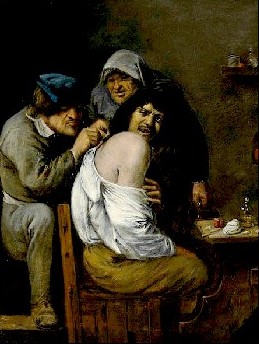
Artist: Joos van Craesbeeck
Cleansing and Treating a Wound (mid 17th c.)
Richard Wiseman recommends that after splinters or the bullet have been removed, the surgeon should "cleanse it from Rags or ought else, and permit the Wound to bleed, accordingly as you in your judgment shall think fit"4. It is interesting that he suggests that the wound be allowed to continue bleeding; in addition to serving the desire to purge the unwanted blood humors from the wound site, the flow of blood could serve to cleanse the wound to a small degree.
In a discussion on wounds of the joints, Moyle recommends stopping the bleeding. You may recall that several of the surgeons (including Wiseman) commented on how little such wound bled. And though this might serve a minor cleansing function, it would also obscure discovery of foreign objects in the wound. As Moyle orders, "You are forthwith to make a strong Ligature above the Joynt (as if it were for amputation) to restrain the blood from flowing to the Wound, whilst you extract the Shot or pieces of Bones."5 The 'Ligature' he recommends is a piece of rope or cloth, basically serving as a tourniquet.
Wiseman includes an interesting step here which no other surgeon mentions: "The Bleeding staid, if there be Hair growing about the Wound, shave it off: then wipe away the clotted Bloud with a Sponge dipt in Red wine, Oxycrate [vinegar and water], or Water."6 This could keep the hair from getting into the wound and interfering with the cure. However, he also suggests that dried blood be left in the wound, explaining that "concreted Bloud keeps the Wound warm, and defends it from the outward Air; and by digestion Nature will thrust it forth."7
Sea surgeon John Atkins likewise recommends cleansing a gunshot wound in one of his case studies. When explaining how to cure such a wound, he recommends that the reader "bring away every Thing extraneous, very loose, or jagged; to wash the Wound well with a warm spirituous Decoction"8.
1,2 John Moyle, The Sea Chirurgeon, 1693, p. 75; 3 Matthias Gottfried Purmann, Churgia Curiosa, 1706, p. 184; 4 Richard Wiseman, Several Chirurgicall Treatises, 1686, p. 341; 5 Moyle, p. 70; 6,7 Wiseman, p. 341; 8 John Atkins, The Navy Surgeon, 1742, p. 143
Step 1: Remove Foreign Objects - Extracting Foreign Materials
"Moreover, in these Wounds, not only the Bullet it self is ordinarily lodged, but many times other strange bodies are carried along with it; for Extraction of which, judicious care and industry are required in you." (Richard Wiseman, Several Chirurgicall Treatises, 1686, p. 409)
A variety of things could be forced into a wound by fast-moving splinters or bullets. Sea surgeon John Woodall tells his surgical reader he must "take away whatsoever is besides nature, as yron, wood, leade, or ought else with fit instruments"1.
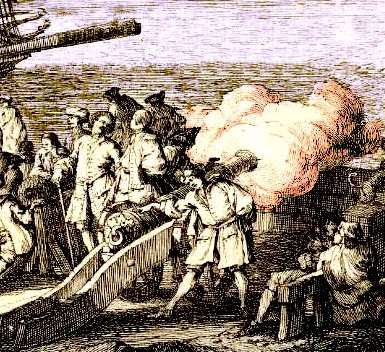
Artist: Jacques Rigaud
Gun Crew Firing, Alere au Depart Avec Coup de Canon (1750)
Military surgeon Richard Wiseman mentions the removal of "Shivers, Splinters, Rags, or ought else" found in a projectile wound.2 He elsewhere explains that "while any of the Rages remain in the Wound, it will never cure"3.
Sea surgeon John Moyle adds a step to this process in one of his case studies of a musket wound to the knee, explaining:
two Intentions immediately offer; to stop the bleeding, and extract the loose bodies. You are forthwith to make a strong Ligature [tie a cord around the leg to act as a tourniquet] above the Joynt (as if it were for amputation) to restrain the blood from flowing to the Wound, whilst you extract the Shot, or pieces of Bones.4
Fellow sea surgeon John Atkins mentions another practical consideration for effective removal of foreign objects in such wounds. He says, "Flesh Wounds, especially by Great Guns or Splinters, are commonly large enough to discover any extraneous Body"5. Wiseman similarly suggests that "though the Wound be large on one side and hang gaping down with great Fracture of Bones, be not discouraged, the largeness of the Wound will make for your better pulling out those extraneous bodies"6.
Moyle expressed particular concern for bone fragments in such wounds, which would have occurred in compound wounds. Large pieces of bone fragment were to be removed at the first dressing of the wound,
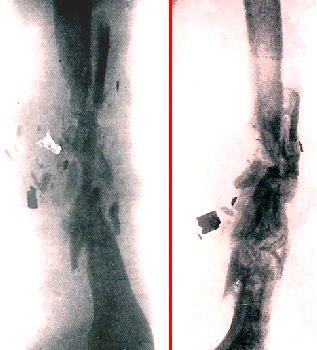
Two X-Rays of Fractured Arm With Metal Fragments,
From
the Journal of Roentgenology (1919)
but "shattered bones will be long a coming out, some at one dressing, and some at another; but when they are all out, and the rest clean and sound, then the bone will cover with good flesh"7.
Atkins suggests an interesting method for removing foreign objects. He says "if any Bits of Rag are suspected [to lie] out of Sight, inject forcibly with Wine and Ol. Tereb. [oil of turpentine] warm’d"8. This injection of fluids would hopefully wash out the smaller and more pliable bits of detritus. Where a wound was bleeding, Atkins suggested also using "Pledgets [compresses of material]; concluding with one or two of those already armed with Digestive [medicine to encourage healing], or a Piece of Cerate [medicated wax], and a Bunting [a soft cloth] Rowler."9
Timing of foreign object removal was also a concern expressed by surgeons during this period. Moyle recommended that if there were pieces of shattered bone in a bullet wound, they should be removed "whilst the Man is hot", referring to the fact that this would be less painfully done while they were still excited by the situation.10 Richard Wiseman likewise explains that parts wounded by gunshot "at first dressing to be cleared with what diligence you can of all such forrein bodies as have made violent intrusion into it, while the Patient is warm with the heat of Battel, and the Wound fresh, and very little altered by either Air or Accidents: Upon which consideration less Pain must necessarily follow upon the Extraction."11 Atkins notes that "Surprise and Warmth of Spirit, when Life has made a glorious Escape, makes them more regardless of their wounds; and therefore such as are judged curable, should have immediate Extraction of what is extraneous in them"12.
All this advice notwithstanding, it was sometimes best to wait. Wiseman notes that when something
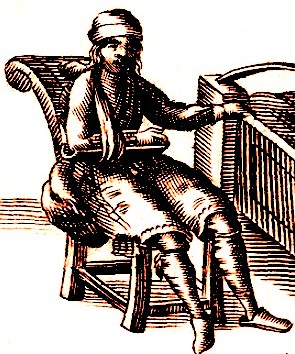
Artist: Jonas Arnold Delineavi
Waiting For Nature, Fractured Arm in a Sling, From
Armamentarium Chirurgicum Bipartitum, p. 68 (1666)
will not come out of the wound or removal of a weapon threatens the life of a patient,
it is of necessity to be left to Nature, who in this case sometimes worketh Miracles. For I have known pieces of Splinters, &c. sometimes stick so fast in the inward Parts, or to have been so inclosed, that we could by no means get them out: yet at length, upon Apostemation [formation of pus] of the Part, they have thrust forth.13
Wiseman also points out that extracting a weapon might cause too much damage if it is removed too violently. In this case, the surgeon must "thrust the Weapon through, or make way for it by Incision on the contrary side: but beware the Weapon be not too big, lest you do make two large Wounds for one."14
Former sea surgeon Tobias Smollet used his real life experiences to write a humorous fictional account of a naval surgeon. In that book, he uses a rather interesting method while operating on a man with a large splinter. He explains that "having sawed off part of the splinter that stuck through the skin, we reduced [set the bone in] the fracture, dressed the wound, applied the eighteen-tailed bandage, and put the leg in a box, secundum artem [according to art]."15 The fictional patient healed in six weeks time.
1 John Woodall, the surgions mate, 1617, p. 128; 2 Richard Wiseman, Several Chirurgicall Treatises, 1686, p. 451-2; 3 Wiseman, p. 410; 4 John Moyle, The Sea Chirurgeon, 1693, p. 69-70; 5 John Atkins, The Navy Surgeon, 1742, p. 148; 6 Wiseman, p. 451; 7 Moyle, p. 72; 8 Atkins, p. 148-9; 9 Atkins, p. 149; 10 Moyle, p. 70; 11 Wiseman, p. 410; 12 Atkins,p. 147; 13,14 Wiseman, p. 341; 15 Tobias Smollett, The Adventures of Roderick Random, p. 186
Step 1: Remove Foreign Objects - Removing the Bullet
"Bullet[s] in the Body must be drawn out, as soon as possibly it can be done without danger, in order to set upon the Cure of the wound caused by it." (Matthias Gottfried Purmann, Churgia Curiosa, 1706, p. 184)
Surgeons during this period had a particular regard for quick removal of bullets. Part of the reason for this was because the patient was less apt to feel the pain of such an operation, as discussed in the previous section.
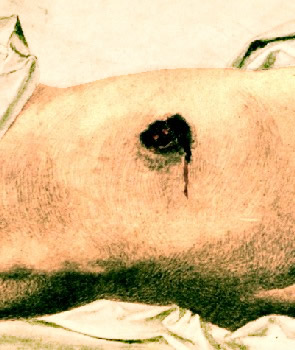
Photo:
George A. Otis -
Gunshot Wound (1864)
However, another reason identified by period surgeons as unique to bullet wounds was how the body dealt with the wound.
For after the first and second day the Wound proveth tumefied [swollen], also the neighboring parts are inflamed, and so changed in their temper [condition], that they conceal from your sight both the Bullet and his companions, so that the place they are coucht in can hardly be known; or, being discovered, you cannot without hazard of your Patient, or great trouble of the Part, make Extraction of them.1
Because of this, surgeons recommended removing the bullet as quickly as possible.
Removal of bullets was made particularly challenging in the case of bullet wounds for a variety of reasons. Bullets could penetrate deeply into the body, making finding them a particular challenge for the surgeon. They also left small opening wounds which would make it more difficult for the surgeon to work with the tools he had available to him. Although there were devices for opening wounds as discussed previously, sometimes the surgeon had to enlarge the wound so that he could get his instruments in to get at the bullet and other foreign objects it had brought into the body with it. If the bullet had gone in deeply enough, it could be better to cut through undamaged skin to get at it. Once the bullet was located and access was available to it, extraction was actually a fairly straightforward process using the tools such as fingers, forceps and the terebellum.
1 Richard Wiseman, Several Chirurgicall Treatises, 1686, p. 410
Removing the Bullet - Finding It
Finding the bullet was particularly challenging when it went deeply into the body. Richard Wiseman explained that the search was made more complicated because "the place by which it enters presently contracts closer". He also said that it was "wonderful to consider how these Shots do twirl about, at least seem to do so"1.
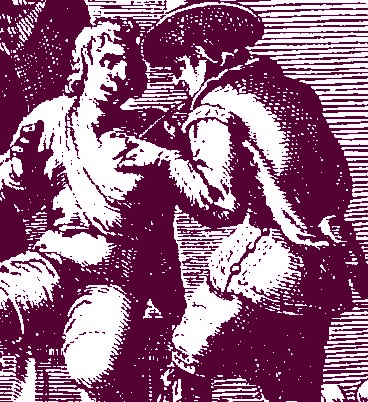
Searching For the Bullet, From The Chyrurgeons Storehouse,
Frontispiece,
Johannes Scultetus (1674)
The first recommendation Wiseman makes is to "place the Patient as near as may be guessed in the posture he was in when first shot" so that the entry wound left by the bullet forms a straight line.2 This idea is also found in the books of French surgeon Ambroise Paré and sea surgeon John Moyle. Paré explains that "otherwise the various motions and turning of the Muscles will either hinder or straiten [tighten] the passage forth of the contained bodies."3 Moyle agrees, noting that "otherwise you will hardly extract the bullet."4 Wiseman adds that if the patient is unable to assume the same position as he was in due to his injury, "let him be laid in a Position which may as nearly answer it as may be, lest some part of a Muscle, Tendon or Ligament obscure what you desire to make manifest."5
With deep bullet wounds, the surgeon had to "make Probation and find the Shot (if possible)"6. Moyle emphasizes that the surgeon must do so "with your long Probe."7 Wiseman gives the surgeon a little more leeway, advising the surgeon to "make search for them with your Finger or Probe."8 The trouble with the probe was that it lacked the sensitivity of the surgeon's fingers, as explained in the section on foreign object extraction tools.
Sometimes the bullet could not be extracted quickly, but the surgeon still wanted to find and remove it. In such cases Wiseman advised that "the Pain where the Bullet lodges doth sometimes help to discover it."9
1,2 Richard Wiseman, Several Chirurgicall Treatises, 1686, p. 411; 3 Ambroise Paré, The Workes of that Famous Chirurgion Ambrose Parey, 1649, p.316-7; 4 John Moyle, The Sea Chirurgeon, 1693, p. 71; 5 Wiseman, p. 411; 6 Moyle, p. 70; 7 Moyle, p. 73; 8,9 Wiseman, p. 411
Removing the Bullet - Making Incision

The Author's Terebellum, Probe, Scalpel,
Bistoury Knife and a Bullet
On occasion it was necessary to make an incision to open the existing wound in order to retrieve the bullet with the tools that the surgeon had available to him. French surgeon Ambroise Paré advised:
The Wound must forthwith be inlarged, unless the condition of the part resist, that so there may be free passage forth both for the Sanies [serum, blood and/or pus, discharged by wounds], or matter, as also for such things as are farced [stuffed inside], or otherwise contained therein; such as are pieces of their cloaths, bombast [padding material], linnen, paper, pieces of Mail or Armour, Bullets, Hail-shot, splinters of bones, bruised flesh and the like, all which must be plucked forth with as much celerity and gentleness as may be.1
The other, more often mentioned, use for incision was when the bullet had gone in too far to be removed easily with the surgeon's bullet extraction tools. Richard Wiseman says that when removing a extraneous objects from a bullet wound, there were two ways to retrieve them. "First, one to extract them by the way they went in: The other, to open the way by which they would, if their force had not failed them, have passed themselves through."2
Sea surgeon John Moyle echoes this, suggesting that "if the Shot be almost through then with your hollow extruding Button force against it, and so cut it out on the contrary side"3. The 'hollow extruding button' probably refers to a thin probe-like tool with a knob on the end which would be used here to push against the shot. He elsewhere uses such a tool to force things down the throat called a depulsor which he says is "of Silver... [or] of Steel, with a Button at the end"4.
There are several examples of bullets being cut out of the skin upon discovery by the surgeon. Sea surgeon Hugh Ryder details a case study involving a man who was shot from the shoulder into the throat where the patient "made sign of being choakt with his Finger, whereupon feeling the Bullet, I made incision, and taking it out gave it him"5. In one of his case studies, Paré found a bullet using his fingers to press the skin near the wound. "Wherefore the Bullet being taken forth by making incision in the place [where Paré had found it], the Wound was quickly healed, and the Gentleman recovered."6
Wiseman later explains that when a surgeon is searching for a bullet, "Pain there will be a good sign of it. If no Accidents occasioned that Pain, make your way there by Incision, avoiding the Vessels, and take out the Shot, and what else offers itself."7
1 Ambroise Paré, The Workes of that Famous Chirurgion Ambrose Parey, 1649, p. 315; 2 Richard Wiseman, Several Chirurgicall Treatises, 1686, p. 411; 3 John Moyle, The Sea Chirurgeon, 1693, p. 73; 4 Moyle, p. 239-40; 5 Hugh Ryder, New Practical Observations in Surgery Containing Divers Remarkable Cases and Cures, 1685, p. 82; 6 Paré, p. 316; 7 Wiseman, p. 412
Removing the Bullet - Extraction
Once the bullet was located and a pathway made for getting at it, extraction was fairly straightforward. At one point in his discussion of bullet removal, sea surgeon John Moyle simply advises "if it is not almost through, but deep in, extract it with your Terebellum; or if it is but a little way in, you may get it out with large Forceps."1
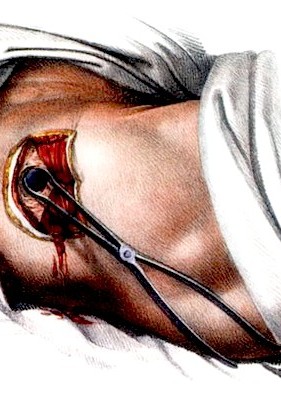
Artist: Nicholas Henrie Jacob
Removing a Bullet with Forceps, From Traite
Complet de l'Anatomie de l'Homme, by Jean
Marc Bourgery (1840)
Richard Wiseman elaborates a bit more on the process. He starts by warning the reader, "In the work of Extraction, take great care you lay not hold of some Nerve or Tendon, and so pluck them along with the Bullet: For by so doing you will cause intolerable Pain and grievous Accidents."2 He adds an interesting comment that may hint that he worked with some of the more elaborate mechanical devices discussed in the tools section of this article. "You must therefore neither open nor dilate your Instruments, until you take hold of the Bullet without any of the circumjacent Parts."3 Or it may just be a reference to how wide the forceps jaws opened.
Moyle also tell his readers, "with your Teribellum, or other Instrument, extract it, giving the man a spoonful of Cordial [a distilled spirit of some kind] in the mean time to chear his fainting Spirits"4. It is sometimes suggested that men would be given alcohol as a sort of period anesthesia for a painful operation such as this. However, Moyle doesn't suggest giving the cordial until after the bullet has been removed. As already mentioned, the best anesthesia was felt to be the performance of the operation quickly while the patient was still excited by the heat of battle and the newness of the wound.
Fellow sea surgeon John Atkins advises something a little different, pointing towards alcohol being given before an operation when describing the makeshift surgical theater on a ship under attack. He says, "To all [the patients on the orlop deck] we must give Cordials at this Time; and Wine has, in my Opinion, the Preferences; because we are to quench Thirst, as well as refresh the Spirits."5 However, Atkins' comment is not tied to the operation itself; just before this statement he talks about "those [patients who are] more helpless [are] to be laid by your Assistants in their Stead, keeping your Cockpit as clear as possible" while the surgeon performed surgery.6 Taken with his comments on refreshing spirits (keeping the men from fainting) and quenching thirst, it can be seen that killing pain was not the primary objective of administering such spirits.
1 John Moyle, The Sea Chirurgeon, 1693, p. 73-4; 2,3 Richard Wiseman, Several Chirurgicall Treatises, 1686, p. 412; 4 Moyle, p. 74; 5,6 John Atkins, The Navy Surgeon, 1742, p. 148
Step 1: Remove Foreign Objects - Not Removing the Bullet
Sometimes the surgeons from this era felt it was best not to remove the bullet at all, but let nature handle its disposition. Richard Wiseman explains that bullets are sometimes lodged "so that the place they are coucht in can hardly be known; or, being discovered, you cannot without hazard of your Patient, or great trouble of the Part, make Extraction of them."1 Sea surgeon John Moyle says concurs, especially when a bullet "is behind some considerable Nerve or Tendon, and you cannot come at it"2.
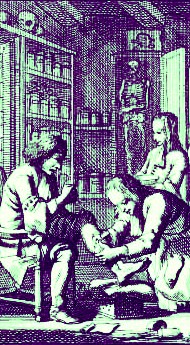
Artist: Caspar Luyken
Examining a Leg, Chirgijn (1694)
Most of the surgeons agreed that leaving a lead bullet in the body for some period of time was not a problem. Ambroise Paré advised that "Leaden Bullets lye in some parts of the body some whiles seaven, eight or more years, so that they neither hinder the agglutination of the Wound, neither doth any other symptom happen thereupon, as I have divers times observed"3. Wiseman says that "the Bullet may lie long there, and do little harm."4
However, Wiseman also warns that this is only true for lead bullets because "Iron or Brass cannot (by reason of their aptness to rust) remain without doing harm."5 Paré adds to this that "bullets of stone, iron and of any other metal, are of another nature, for they cannot remain any long time in the body without hurt; for Iron will grow rusty, and so corrode the neighbouring bodies, and bring other malign symptomes."6 While bullets of materials such as stone and iron are less likely to have been used during the golden age of piracy, other objects made of such materials may have been fired from cannons or placed in grenadoes - primitive grenades made from round, hollow cast iron balls filled with gunpowder and various pieces of shrapnel - during the period and been forced into the body.
When a bullet was left in place, Moyle said "'tis no great matter, for it will of it self descend (by its own weight) lower and lower (its passage healing after it as it descends) till at last it falls to some depending Part, and to the very Skin, where you may feel it, and cut it out."7 Paré agrees, explaining that "at length by the strength of nature forcing them, and their proper weightiness bearing them downwards, they shew themselves in some lower part, by their swelling or bunching forth, and so must be taken forth by the hand of the Chirurgeon."8
Despite admitting that bullets can be left in place, Wiseman actually does not recommend doing so unless it is necessary. He warns that "the Bullet pierceth not any Part without carrying Rags along with it, which corrupt in the Wound, and make Apostemations [formations of pus], occasioning a prolonging the Cure; as must needs be observed by all men in their practice."9 Paré only favors leaving lead bullets in place 'in the fleshy parts' because "a leaden bullet cannot remain any long time in nervous, or other noble parts without danger."10
1 Richard Wiseman, Several Chirurgicall Treatises, 1686, p. 410; 2 John Moyle, The Sea Chirurgeon, 1693, p. 74; 3 Ambroise Paré, The Workes of that Famous Chirurgion Ambrose Parey, 1649, p. 322; 4,5 Wiseman, p. 410; 6 Paré, p. 322; 7 Moyle, p. 74; 8 Paré, p. 322; 9 Wiseman, p. 410; 10 Paré, p. 322

